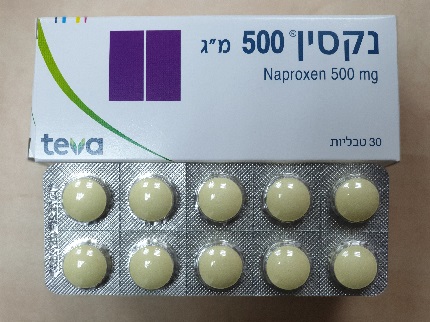Quest for the right Drug

נקסין 500 מ"ג NAXYN 500 MG (NAPROXEN)
תרופה במרשם
תרופה בסל
נרקוטיקה
ציטוטוקסיקה
צורת מתן:
פומי : PER OS
צורת מינון:
טבליה : TABLETS
עלון לרופא
מינוניםPosology התוויות
Indications תופעות לוואי
Adverse reactions התוויות נגד
Contraindications אינטראקציות
Interactions מינון יתר
Overdose הריון/הנקה
Pregnancy & Lactation אוכלוסיות מיוחדות
Special populations תכונות פרמקולוגיות
Pharmacological properties מידע רוקחי
Pharmaceutical particulars אזהרת שימוש
Special Warning עלון לרופא
Physicians Leaflet
Pregnancy & Lactation : הריון/הנקה
4.6 Fertility, pregnancy and lactation Pregnancy Inhibition of prostaglandin synthesis may adversely affect the pregnancy and/or the embryo/foetal development. Data from epidemiological studies suggest an increased risk of miscarriage and of cardiac malformation and gastroschisis after use of a prostaglandin synthesis inhibitor in early pregnancy. The absolute risk for cardiovascular malformation was increased from less than 1%, up to approximately 1.5 %. The risk is believed to increase with dose and duration of therapy. In animals, administration of a prostaglandin synthesis inhibitor has been shown to result in increased pre- and post-implantation loss and embryo-foetal lethality. In addition, increased incidences of various malformations, including cardiovascular, have been reported in animals given a prostaglandin synthesis inhibitor during the organogenetic period. From the 20th week of pregnancy onward, naproxen use may cause oligohydramnios resulting from foetal renal dysfunction. These adverse outcomes are seen, on average, after days to weeks of treatment, although oligohydramnios has been infrequently reported as soon as 48 hours after NSAID initiation. Oligohydramnios is often, but not always, reversible with treatment discontinuation. In addition, there have been reports of ductus arteriosus constriction following treatment in the second trimester, most of which resolved after treatment cessation. Therefore, during the first and second trimester of pregnancy, naproxen should not be given unless clearly necessary. If naproxen is used by a woman attempting to conceive, or during the first and second trimester of pregnancy, the dose should be kept as low and duration of treatment as short as possible. Antenatal monitoring for oligohydramnios and ductus arteriosus constriction should be considered after exposure to naproxen for several days from gestational week 20 onward. Consider ultrasound monitoring of amniotic fluid if naproxen treatment extends beyond 5 days. Naproxen should be discontinued if oligohydramnios or ductus arteriosus constriction are found. During the third trimester of pregnancy, all prostaglandin synthesis inhibitors may expose the foetus to: - cardiopulmonary toxicity (premature constriction/closure of the ductus arteriosus and pulmonary hypertension); - renal dysfunction (see above); The mother and neonate, at the end of pregnancy, to: - possible prolongation of bleeding time, an anti-aggregating effect which may occur even at very low doses; - inhibition of uterine contractions resulting in delayed or prolonged labour. Consequently, Naproxen is contraindicated during pregnancy. See point 4.3 and 5.3) Breast feeding Naproxen has been found in the milk of lactating women. The use of Naxyn should be avoided in patients who are breast-feeding. Fertility The use of naproxen, as with any drug known to inhibit cyclooxygenase/prostaglandin synthesis, may impair fertility and is not recommended in women attempting to conceive. In women who have difficulty conceiving or are undergoing investigation of infertility, withdrawal of naproxen should be considered.

שימוש לפי פנקס קופ''ח כללית 1994
Rheumatoid arthritis & osteoarthritis, non rheumatic inflammatory conditions, acute gouty arthritis, dysmenorrhea
תאריך הכללה מקורי בסל
01/01/1995
הגבלות
תרופה שאושרה לשימוש כללי בקופ'ח
מידע נוסף
